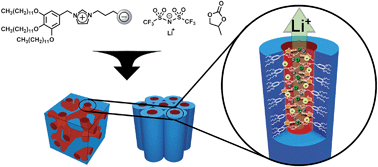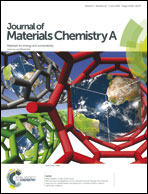Zwitterionic liquid crystals as 1D and 3D lithium ion transport media†
Abstract
We describe the development of self-assembled one- and three-dimensional lithium ion conductors composed of zwitterionic liquid crystals, lithium bis(trifluoromethylsulfonyl)imide (LiTFSI) and propylene carbonate (PC). Two types of wedge-shaped zwitterions based on imidazolium dicyanoethenolate and sulfonate were synthesized. These compounds alone show liquid-crystalline (LC) columnar hexagonal (Colh) phases and low ionic conductivities (10−8 to 10−7 S cm−1). The increase in the ionic conductivities was achieved by the addition of LiTFSI (10−5 S cm−1) followed by that of PC (10−4 S cm−1). Moreover, LC bicontinuous cubic (Cubbi) phases are induced by tuning the ionic nature of the zwitterionic liquid crystal with the ratio of LiTFSI and PC. The dissociation of LiTFSI in the zwitterions and the ion–dipole interaction between the lithium ions and PC are shown to be significant keys for the enhancement of the conductivities and stabilization of the nanosegregated LC structures.

- This article is part of the themed collection: 2015 Journal of Materials Chemistry A Hot Papers

 Please wait while we load your content...
Please wait while we load your content...